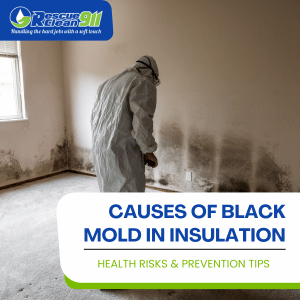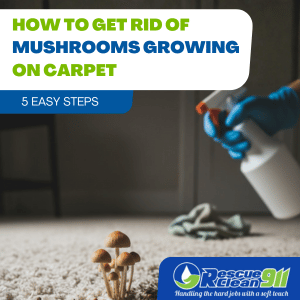Mold from water damage is a common issue that occurs when excess moisture from leaks or flooding creates the right conditions for mold spores to grow and spread. Mold can cause significant damage and health problems if not addressed promptly.
Guide
Understanding Mold and Its Causes
Mold is a type of fungus that thrives in damp, humid conditions. There are many types of mold, but black mold (Stachybotrys chartarum) is one of the most well-known and feared. Mold can grow indoors on a variety of surfaces, especially organic materials like wood, paper, and fabric. It can appear in different colors, including black, green, white, and orange.
Mold spores are tiny, lightweight particles that travel through the air. When these spores land on damp surfaces, they can begin to grow and form mold colonies. Mold is often found in areas with high humidity, such as bathrooms, kitchens, and basements. It can also grow in hidden places like inside walls, under carpets, and behind furniture.

Mold as a Cause of Water Damage: Why It Happens and What to Do
Water damage is a leading cause of mold growth, creating an environment where mold can thrive and spread rapidly. Understanding why water damage leads to mold, how to address it, and what steps to take to prevent it are essential in maintaining a healthy living space.
Why Is There Mold?
Mold thrives in moist environments, and water damage provides the perfect breeding ground. The presence of mold in your home following water damage can often be traced to several common causes:
- Roof Leaks: Damaged or missing shingles, flashing failures, and clogged gutters can lead to roof leaks. When water seeps into your home through the roof, it can saturate ceilings, walls, and insulation, creating an ideal environment for mold growth.
- Plumbing Leaks: Leaking pipes, faucets, or fixtures can result in water accumulating in hidden areas such as behind walls, under floors, or within cabinetry. This hidden moisture can lead to undetected mold growth.
- Flooding: Natural disasters like hurricanes, heavy rains, or overflowing rivers can cause significant water damage. Floodwaters can inundate basements, crawl spaces, and lower levels of homes, leaving behind moisture that promotes mold growth.
- Condensation: Poor ventilation in areas like bathrooms, kitchens, and basements can lead to condensation build-up. This moisture accumulation on surfaces can support mold growth over time.
What to Do If You Suspect Mold from Water Damage
Addressing mold growth promptly is crucial to prevent further damage and protect your health. Here are some steps to take if you suspect mold resulting from water damage:
- Identify and Fix the Source of Water: The first step is to identify and repair the source of the water damage. Whether it’s a leaky roof, plumbing issue, or inadequate ventilation, resolving the moisture source is critical to prevent further mold growth.
- Dry Affected Areas Immediately: Time is of the essence when dealing with water damage. Use fans, dehumidifiers, and heaters to dry the affected areas within 24 to 48 hours. Ensure all wet materials, including carpets, drywall, and insulation, are thoroughly dried.
- Remove Damaged Materials: Materials that have been heavily soaked or show signs of mold should be removed and replaced. This may include drywall, insulation, carpets, and furniture. Proper disposal of these materials helps prevent mold spores from spreading.
- Clean and Disinfect: Use appropriate cleaning solutions, such as a mixture of water and detergent or commercial mold removers, to clean and disinfect affected surfaces. For severe mold infestations, consider using antifungal and antimicrobial treatments to kill mold spores and prevent regrowth.
- Monitor and Maintain Low Humidity Levels: Keep indoor humidity levels below 60% using dehumidifiers and ensure proper ventilation. Regularly inspect areas prone to moisture accumulation and promptly address any signs of water damage or mold.
- Excess moisture and high relative humidity levels also contribute to mold growth. Mold needs moisture to grow, so areas with high humidity are at greater risk. Poor ventilation, condensation, and damp basements can all lead to high humidity and mold problems. It’s important to control moisture levels in your home to prevent mold growth.
Preventing Mold After Water Damage
Preventing mold growth after water damage involves taking quick and effective action. Here are some steps you can take to prevent mold growth:
- Control Moisture Levels: Use dehumidifiers and air conditioners to keep humidity levels low. Aim for a relative humidity level below 60% to prevent mold growth.
- Fix Leaks Promptly: Repair any water leaks, including roof and plumbing leaks, as soon as they are discovered. Even small leaks can lead to significant mold problems if left unaddressed.
- Dry Affected Areas: After water damage, dry affected areas thoroughly within 24 to 48 hours. Use fans, heaters, and dehumidifiers to speed up the drying process.

Identifying Mold in Your Home
Recognizing the signs of mold in your home is crucial for addressing the problem early. Here are some common indicators of mold presence:
- Visible Mold: Mold often appears as black, green, or white spots on walls, ceilings, and other surfaces. It may look fuzzy or slimy.
- Musty Odors: Musty odors are another indicator of mold, even if you can’t see it. Mold can hide behind walls, under carpets, and in other hidden areas.
- Mold Inspection: If you suspect mold but can’t see it, consider hiring a professional for a mold inspection. They can identify hidden mold and assess the extent of the problem.
- Mold Testing: Professional mold testing can confirm the presence of mold and determine the types of mold present. This can be important for identifying toxic mold like black mold.
Health Risks Associated with Mold Exposure
Mold exposure can lead to health problems. People with respiratory problems, allergies, or weakened immune systems are especially vulnerable. Common health effects of mold exposure include:
- Respiratory Problems: Mold spores can irritate the respiratory system, leading to coughing, wheezing, and shortness of breath. Individuals with asthma may experience more severe symptoms.
- Allergic Reactions: Mold can trigger allergic reactions, such as sneezing, runny nose, itchy eyes, and skin rashes. People with mold allergies are more likely to have these symptoms.
- Sore Throat and Runny Nose: Mold exposure can cause sore throat and runny nose, which can be mistaken for cold or allergy symptoms.
- Adverse Health Effects: In severe cases, mold exposure can cause more serious health problems, including infections and toxic reactions.
Mold Remediation Process
If mold has already developed, it’s important to address the problem promptly to prevent further damage and health risks. The mold remediation process involves several steps:
- Assessment: A professional mold remediation company will assess the extent of the mold problem and determine the best course of action.
- Containment: To prevent mold spores from spreading, the affected area is sealed off using plastic sheeting and negative air pressure.
- Removal: Mold and affected materials, such as drywall, carpeting, and insulation, are removed and disposed of properly. This may involve cutting out and removing contaminated building materials.
- Cleaning: Surfaces are cleaned with antifungal and antimicrobial treatments to eliminate mold colonies and prevent future growth.
- Drying and Dehumidification: The affected area is thoroughly dried to remove any remaining moisture. This helps prevent mold from returning.
- Restoration: Once the mold remediation process is complete, the affected area is restored to its original condition. This may involve repairing or replacing damaged building materials.

The Value and Benefits of Rescue Clean 911 Services
Professional Expertise and Services
Rescue Clean 911 is your trusted partner in handling mold from water damage. Our team of experts is trained and certified in mold inspection, mold remediation, and water damage restoration. We use state-of-the-art equipment and techniques to ensure your home is safe and mold-free.
Our services include:
Mold Remediation: Our comprehensive mold remediation process includes containment, removal, cleaning, and drying to eliminate mold and prevent future growth. We also perform thorough inspections.
Water Damage Restoration: We address the root cause of mold growth by repairing water damage and drying affected areas to prevent mold from returning.
Choosing Rescue Clean 911 for your mold and water damage issues ensures peace of mind and a safe, healthy home environment. Our commitment to quality and customer satisfaction makes us the best choice for mold remediation and water damage restoration.
If you’re dealing with mold from water damage, don’t wait to address the problem. Contact Rescue Clean 911 today for professional mold remediation and water damage restoration services. Let our experts handle the job so you can have peace of mind and a healthy living environment.








